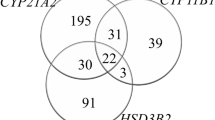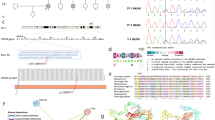Abstract
In this study, we report on two different GJA8 variants related to congenital eye anomalies in two unrelated families, respectively. GJA8 (or Cx50) encoding a transmembrane protein to form lens connexons has been known as a common causative gene in congenital cataracts and its variants have recently been reported related to a wide phenotypic spectrum of eye defects. We identified two GJA8 variants, c.134G>T (p.Try45Leu, W45L) detected in a cataract family by Sanger sequencing and c.281G>A (p.Gly94Glu, G94E) found in a family with severe eye malformations including microphthalmia by whole-exome sequencing. These two variants were absent in healthy population and predicted deleterious by bioinformatic analysis. Furthermore, we compared the expression in cell lines between these mutants and the wildtype to explore their potential mechanism. Cell counting kit-8 assay showed that overexpression of either W45L or G94E decreased cell viability compared with wild-type Cx50 and the control. A lower protein level in W45L found by western blotting and fewer punctate fluorescent signals showed by fluorescence microscopy suggested that W45L may have less protein expression. A higher G94E protein level and abundant dotted distribution indicated that G94E may cause aberrant protein degradation and accumulation. Such results from in vitro assays confirmed the impact of these two variants and gave us a hint about their different pathogenic roles in different phenotypes. In conclusion, our study is the first to have the functional analysis of two GJA8 variants c.134G>T and c.281G>A in Chinese pedigrees and explore the impact of these variants, which can help in prenatal diagnosis and genetic counseling as well in basic studies on GJA8.





Similar content being viewed by others
References
Berthoud VM, Ngezahayo A (2017) Focus on lens connexins. BMC Cell Biol 18:6
Berthoud VM, Minogue PJ, Guo J, Williamson EK, Xu X, Ebihara L, Beyer EC (2003) Loss of function and impaired degradation of a cataract-associated mutant connexin50. Eur J Cell Biol 82:209–221
Berthoud VM, Minogue PJ, Laing JG, Beyer EC (2004) Pathways for degradation of connexins and gap junctions. Cardiovasc Res 62:256–267
Beyer EC, Berthoud VM (2014) Connexin hemichannels in the lens. Front Physiol 5:20
Beyer EC, Ebihara L, Berthoud VM (2013) Connexin mutants and cataracts. Front Pharmacol 4:43
Ceroni F, Aguilera-Garcia D, Chassaing N, Bax DA, Blanco-Kelly F, Ramos P, Tarilonte M, Villaverde C, da Silva LRJ, Ballesta-Martinez MJ, Sanchez-Soler MJ, Holt RJ, Cooper-Charles L, Bruty J, Wallis Y, McMullan D, Hoffman J, Bunyan D, Stewart A, Stewart H, Lachlan K, Fryer A, McKay V, Roume J, Dureau P, Saggar A, Griffiths M, Calvas P, Ayuso C, Corton M, Ragge NK (2019) New GJA8 variants and phenotypes highlight its critical role in a broad spectrum of eye anomalies. Hum Genet 138:1027–1042
Garcia IE, Prado P, Pupo A, Jara O, Rojas-Gomez D, Mujica P, Flores-Munoz C, Gonzalez-Casanova J, Soto-Riveros C, Pinto BI, Retamal MA, Gonzalez C, Martinez AD (2016) Connexinopathies: a structural and functional glimpse. BMC Cell Biol 17(Suppl 1):17
Garcia-Mata R, Gao YS, Sztul E (2002) Hassles with taking out the garbage: aggravating aggresomes. Traffic 3:388–396
Ge XL, Zhang Y, Wu Y, Lv J, Zhang W, Jin ZB, Qu J, Gu F (2014) Identification of a novel GJA8 (Cx50) point mutation causes human dominant congenital cataracts. Sci Rep 4:4121
Jackson D, Malka S, Harding P, Palma J, Dunbar H, Moosajee M (2020) Molecular diagnostic challenges for non-retinal developmental eye disorders in the United Kingdom. Am J Med Genet C Semin Med Genet 184:578–589
Jiang JX (2010) Gap junctions or hemichannel-dependent and independent roles of connexins in cataractogenesis and lens development. Curr Mol Med 10:851–863
Kopito RR (2000) Aggresomes, inclusion bodies and protein aggregation. Trends Cell Biol 10:524–530
Laing JG, Beyer EC (1995) The gap junction protein connexin43 is degraded via the ubiquitin proteasome pathway. J Biol Chem 270:26399–26403
Laing JG, Tadros PN, Westphale EM, Beyer EC (1997) Degradation of connexin43 gap junctions involves both the proteasome and the lysosome. Exp Cell Res 236:482–492
Li L, Fan DB, Zhao YT, Li Y, Yang ZB, Zheng GY (2019) GJA8 missense mutation disrupts hemichannels and induces cell apoptosis in human lens epithelial cells. Sci Rep 9:19157
Li J, Chen X, Yan Y, Yao K (2020) Molecular genetics of congenital cataracts. Exp Eye Res 191:107872
Lichtenstein A, Minogue PJ, Beyer EC, Berthoud VM (2011) Autophagy: a pathway that contributes to connexin degradation. J Cell Sci 124:910–920
Ma AS, Grigg JR, Prokudin I, Flaherty M, Bennetts B, Jamieson RV (2018) New mutations in GJA8 expand the phenotype to include total sclerocornea. Clin Genet 93:155–159
Ma A, Yousoof S, Grigg JR, Flaherty M, Minoche AE, Cowley MJ, Nash BM, Ho G, Gayagay T, Lai T, Farnsworth E, Hackett EL, Fisk K, Wong K, Holman KJ, Jenkins G, Cheng A, Martin F, Karaconji T, Elder JE, Enriquez A, Wilson M, Amor DJ, Stutterd CA, Kamien B, Nelson J, Dinger ME, Bennetts B, Jamieson RV (2020) Revealing hidden genetic diagnoses in the ocular anterior segment disorders. Genet Med 22:1623–1632
Minogue PJ, Tong JJ, Arora A, Russell-Eggitt I, Hunt DM, Moore AT, Ebihara L, Beyer EC, Berthoud VM (2009) A mutant connexin50 with enhanced hemichannel function leads to cell death. Invest Ophthalmol vis Sci 50:5837–5845
Mohebi M, Chenari S, Akbari A, Ghassemi F, Zarei-Ghanavati M, Fakhraie G, Babaie N, Heidari M (2017) Mutation analysis of connexin 50 gene among Iranian families with autosomal dominant cataracts. Iran J Basic Med Sci 20:288–293
Ping X, Liang J, Shi K, Bao J, Wu J, Yu X, Tang X, Zou J, Shentu X (2021) Rapamycin relieves the cataract caused by ablation of Gja8b through stimulating autophagy in zebrafish. Autophagy 17:3323–3337
Richards S, Aziz N, Bale S, Bick D, Das S, Gastier-Foster J, Grody WW, Hegde M, Lyon E, Spector E, Voelkerding K, Rehm HL, Committee ALQA (2015) Standards and guidelines for the interpretation of sequence variants: a joint consensus recommendation of the American College of Medical Genetics and Genomics and the Association for Molecular Pathology. Genet Med 17:405–424
Sellitto C, Li L, White TW (2004) Connexin50 is essential for normal postnatal lens cell proliferation. Invest Ophthalmol vis Sci 45:3196–3202
Shiels A, Hejtmancik JF (2017) Mutations and mechanisms in congenital and age-related cataracts. Exp Eye Res 156:95–102
Shiels A, Bennett TM, Hejtmancik JF (2010) Cat-Map: putting cataract on the map. Mol vis 16:2007–2015
Su D, Yang Z, Li Q, Guan L, Zhang H, E D, Zhang L, Zhu S, Ma X, (2013) Identification and functional analysis of GJA8 mutation in a Chinese family with autosomal dominant perinuclear cataracts. PLoS One 8:e59926
Wang K, Gu S, Yin X, Weintraub ST, Hua Z, Jiang JX (2012) Developmental truncations of connexin 50 by caspases adaptively regulate gap junctions/hemichannels and protect lens cells against ultraviolet radiation. J Biol Chem 287:15786–15797
White TW (2002) Unique and redundant connexin contributions to lens development. Science 295:319–320
Williamson KA, FitzPatrick DR (2014) The genetic architecture of microphthalmia, anophthalmia and coloboma. Eur J Med Genet 57:369–380
Wu Z, Meng D, Fang C, Li J, Zheng X, Lin J, Zeng H, Lv S, Zhang Z, Luan B, Zhong Z, Chen J (2019) PITX3 mutations associated with autosomal dominant congenital cataract in the Chinese population. Mol Med Rep 19:3123–3131
Yu Y, Wu M, Chen X, Zhu Y, Gong X, Yao K (2016) Identification and functional analysis of two novel connexin 50 mutations associated with autosome dominant congenital cataracts. Sci Rep 6:26551
Zhang L, Liang Y, Zhou Y, Zeng H, Jia S, Shi J (2018) A missense mutation in gja8 encoding connexin 50 in a Chinese pedigree with autosomal dominant congenital cataract. Tohoku J Exp Med 244:105–111
Acknowledgements
We appreciated all the volunteers for participating in this study. This project was supported by the Ministry of Science and Technology of China (2021YFA1101300 and 2020YFA0112500), the National Key basic Research Program of China (973 Program 2015CB964601), and the National Nature Science Foundation of China (81371062).
Funding
The Ministry of Science and Technology of China, Grant/Award Number: 2021YFA1101300 and 2020YFA0112500; the National Key Basic Research Program of China (973 Program 2015CB964601) and the National Nature Science Foundation of China (81371062).
Author information
Authors and Affiliations
Corresponding author
Ethics declarations
Conflict of interest
The authors declare that they have no conflict of interest.
Additional information
Communicated by Shuhua Xu.
Publisher's Note
Springer Nature remains neutral with regard to jurisdictional claims in published maps and institutional affiliations.
Supplementary Information
Below is the link to the electronic supplementary material.
Rights and permissions
Springer Nature or its licensor holds exclusive rights to this article under a publishing agreement with the author(s) or other rightsholder(s); author self-archiving of the accepted manuscript version of this article is solely governed by the terms of such publishing agreement and applicable law.
About this article
Cite this article
Zhou, L., Sun, X., Wang, X. et al. Identification and functional analysis of two GJA8 variants in Chinese families with eye anomalies. Mol Genet Genomics 297, 1553–1564 (2022). https://doi.org/10.1007/s00438-022-01939-6
Received:
Accepted:
Published:
Issue Date:
DOI: https://doi.org/10.1007/s00438-022-01939-6




